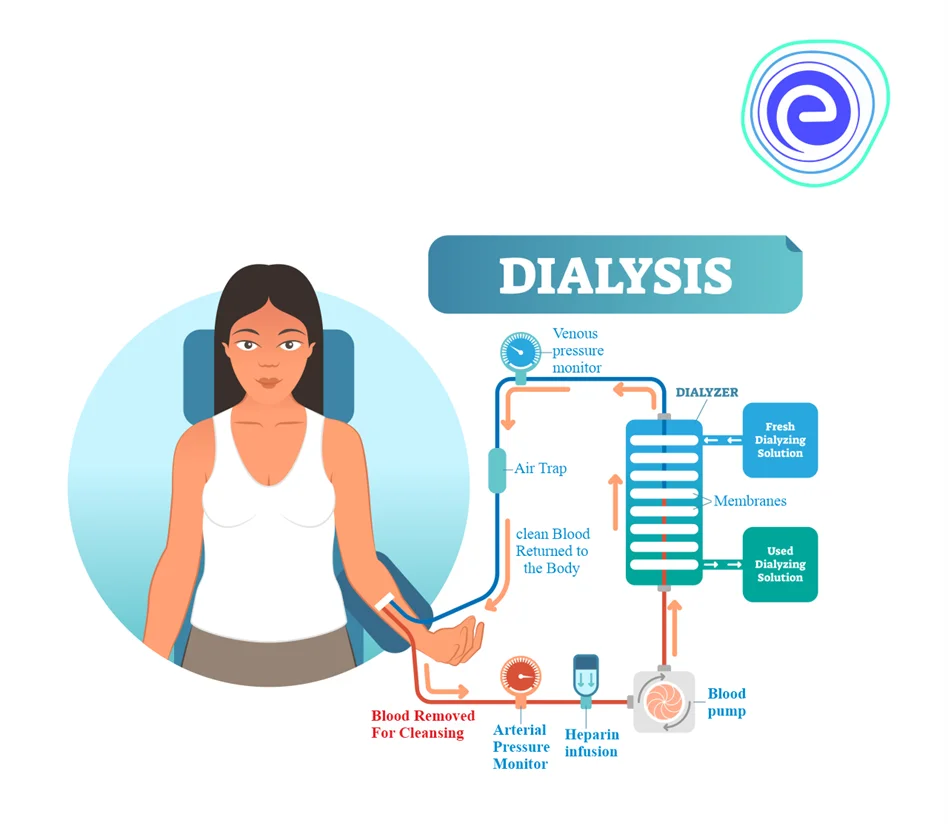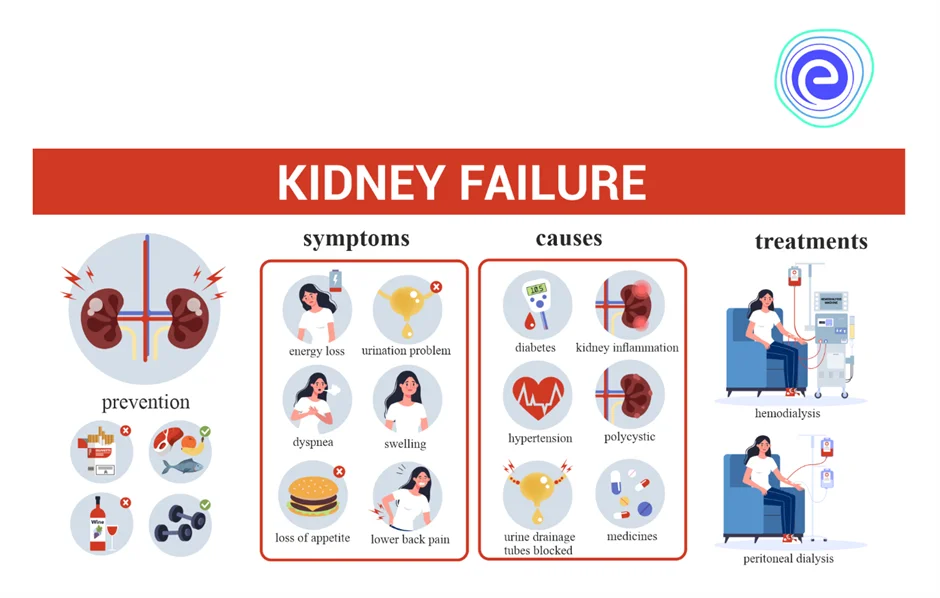- Written By
Shilpi Shikha
- Last Modified 27-12-2024
Dialysis: Principle, Mechanism, Types, Advantages and Side Effects
Dialysis: Have you ever wondered why we have one heart, one stomach, one liver, one brain but two kidneys? All of these organs perform vital functions. What is so special about Kidney? The primary function of the kidney is to remove toxins from the blood and convert waste into urine. They also keep your bones strong, inform your body when to generate new blood cells, and even keep you upright by controlling your blood pressure when you’re walking around all day.
If the kidney starts malfunctioning or stops functioning altogether, it will lead to the accumulation of toxins in the body which may cause various issues including coma and death. For people suffering from renal issues, Dialysis provides a lifeline. Dialysis maintains the body in balance when kidneys fail by eliminating waste, salt, and excess water and preventing them from building up in the body. Let’s learn some more about the life-saving process of Dialysis.
What is Dialysis?
Dialysis is a medical procedure that removes excess water, solutes, and toxins from the blood in people whose kidneys are unable to do so naturally. This is also referred to as renal replacement therapy. Dialysis is based on the concepts of solute diffusion and fluid ultrafiltration across a semipermeable membrane. The first successful dialysis was performed in 1943.
Learn about Haemodialysis here
Who Requires Dialysis?
The kidneys may not be able to clear the blood correctly if they are not functioning properly, such as in severe chronic renal disease (kidney failure). In the body, waste materials and fluid can accumulate to harmful proportions. It’s needed when the kidneys have lost 90% of their function and the glomerular filtration rate is less than 15. Because most kidney failures are irreparable, this therapy may be continued for months or years.
Principle of Dialysis
The principles of solute diffusion and fluid ultrafiltration over a semipermeable membrane underpin dialysis. Diffusion is a feature of chemicals in the water that causes them to travel from a high concentration area to a low concentration area. A dialysate, or specific dialysis fluid, runs through one side of a semi-permeable membrane while blood flows through the other. A semipermeable membrane is a thin layer of material with holes or pores of varying sizes. The membrane allows small solutes and fluids to flow through, but it prevents bigger things from passing through (for example, red blood cells and large proteins). When blood reaches the kidneys, the bigger chemicals are sorted from the smaller ones in the glomerulus, simulating the filtering process that occurs in the kidneys.
Fig: Process of Dialysis
Mechanism of Dialysis
The blood is gently drawn out of the dialysis machine by a pump, which then puts it via a dialyzer. This functions similarly to a kidney, filtering excess salt, waste, and moisture. Through the second needle in the arm, the cleaned blood is reintroduced into the body. Fluid is extracted from the body by ultrafiltration utilising the dialysis membrane in dialysis. The dialysate side has a lower pressure, therefore water travels from the blood (which has a greater pressure) to the dialysate (place of lower pressure). This is how fluid is removed during dialysis.
Types of Dialysis
There are two types of dialysis, both perform normal kidney functions, filtering waste and excess fluid from the blood:
1. Haemodialysis: This method involves passing the patient’s blood via a dialysis machine, where it is filtered and returned to the patient. The filters, like the kidneys, eliminate waste items from the blood. After that, the filtered blood is returned to the patient via another catheter. The system functions similarly to an artificial kidney. Haemodialysis can be performed in a hospital’s specific dialysis facility or at home.
Fig: Types of Dialysis
2. Peritoneal dialysis: Wastes and water are removed from the blood inside the body utilising the peritoneum as a natural semipermeable membrane in peritoneal dialysis. Wastes and excess water are transported from the bloodstream via the peritoneal membrane and into a dialysate dialysis solution in the abdominal cavity. A sterile dialysate solution rich in minerals and glucose is injected through a tube into the peritoneal cavity, the abdominal body cavity that surrounds the colon, during peritoneal dialysis. The peritoneal membrane is a semi-permeable membrane.
Advantage of Dialysis
When the kidneys are unable to filter the blood sufficiently, dialysis is required. Dialysis gives kidney failing sufferers a chance to live productive lives. Extra water, waste, and other pollutants are kept out of the body by properly functioning kidneys. They also aid in the management of blood pressure and the regulation of chemical element levels in the blood. Dialysis performs functions similar to the kidney which are listed below:
- It keeps your blood pressure in check.
- It flushes the body of extra water and metabolic waste.
- Prevents dangerous quantities of substances like potassium, bicarbonate, and sodium from accumulating.
Side Effects of Dialysis
Dialysis is a lifesaving procedure but it may cause various side effects which are listed below:
- Muscle spasms
- Itchy skin, which is usually worse before or after a procedure
- Blood pressure that is too low, especially in diabetics
- Apnea is a sleep disorder characterised by itching, restless legs, or brief gaps in breathing.
- Patients must take a set amount of liquids each day to avoid fluid excess.
- Infections or ballooning at the dialysis access site
- Depression and mood swings are common.
Dialysis is a medical procedure that removes excess water, solutes, and toxins from the blood in persons whose kidneys are unable to do so naturally. This is also referred to as renal replacement therapy. Dialysis is based on the concepts of solute diffusion and fluid ultrafiltration across a semipermeable membrane. It’s needed when the kidneys have lost 90% of their function and the glomerular filtration rate is less than 15. Because most kidney failures are irreparable, this therapy may be continued for months or years. The principles of solute diffusion and fluid ultrafiltration over a semipermeable membrane underpin dialysis. In the procedure, the blood is gently drawn out of the dialysis machine by a pump, which then puts it via a dialyzer. Fluid is extracted from the body by ultrafiltration utilising the dialysis membrane in dialysis. There are two types of dialysis, both perform normal kidney functions, filtering waste and excess fluid from the blood: Haemodialysis and Peritoneal dialysis. Dialysis performs functions similar to the kidney. Dialysis is a lifesaving procedure but it may cause various side effects.
Frequently Asked Questions (FAQs) on Dialysis
Q.1. Why is dialysis used?
Ans: Dialysis is used to filter and purify the blood using a machine.
Q.2. When does a doctor prescribe dialysis?
Ans: Dialysis is used for patients suffering from serious renal problems like kidney failure.
Q.3. What is the principle of dialysis?
Ans: A dialysis is based on the concepts of solute diffusion and fluid ultrafiltration across a semipermeable membrane.
Q.4. What are the side effects of dialysis?
Ans: Spasms of the muscles, Itchy skin that generally gets worse are some of the side effects of dialysis.
Q.5. When was the first process of dialysis performed?
Ans: The first successful dialysis was performed in 1943.
Hope this detailed article on Dialysis helps you in your exam preparation. If you have any queries or doubts, drop them in the comments section and we will get back to you at the earliest










































